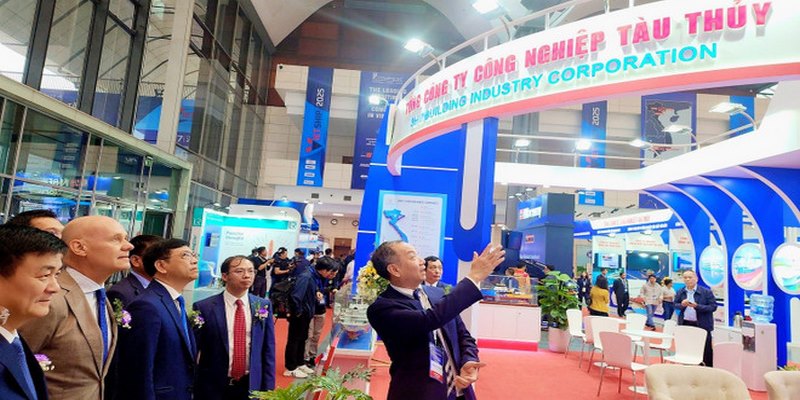Vietnam has a long coastline and a geographically advantageous location for the development of maritime transport and shipbuilding industries, according to leaders of the Vietnam Shipbuilding Industry Corporation (SBIC).
This information was discussed at the seminar titled “Green Transition in the Maritime Industry and Offshore Wind Power – Development Potential in Vietnam,” held within the framework of the 10th International Exhibition on Shipbuilding Technology and Offshore Engineering (Vietship 2025). The event was organized by SBIC in collaboration with Vietnam Shipbuilding Engineering Joint Stock Company (VISEC) and took place from March 5th to 7th in Hanoi.

The organizing committee cut the ribbon to open the event on March 5th. Photo: Vietship 2025
At the seminar, Mr. Hoàng Hồng Giang, Deputy Director of the Vietnam Maritime and Inland Waterways Administration, stated that currently, there are 88 enterprises engaged in shipbuilding for sea vessels and 411 facilities building inland watercraft across the country. Among them, about 120 enterprises build and repair ships with a tonnage greater than 1,000 tons.
According to Mr. Giang, Vietnam’s new shipbuilding capacity reaches approximately 3.5 million tons per year. The Vietnamese shipbuilding industry ranks 7th globally, holding 0.61% of the global market share. The domestic demand for new shipbuilding by 2030 is estimated at around 95 to 245 vessels (equivalent to 16 to 41 vessels per year), with a total tonnage of 4 to 5 million tons (including both newly built ships and replacements for the old fleet).
In this context, Vietnam, with its long coastline and favorable geographical position, holds many competitive advantages in the shipbuilding and maritime transport industry. Mr. Phạm Hoài Chung, Chairman of the Board of Members of the Vietnam Shipbuilding Industry Corporation (SBIC), noted that the demand for maritime transport in Vietnam continues to rise, and exports via sea account for a large proportion of total trade turnover, which is one of the advantages. Furthermore, the government has introduced numerous supportive policies, including promoting international partnership linkages and encouraging investment in infrastructure.

Vietnam’s shipbuilding industry is capable of producing almost all types of ships, including general cargo ships, bulk carriers, oil tankers, and car carriers. The industry has also developed several supporting industrial facilities to back the shipbuilding sector. Meanwhile, foreign-invested shipbuilding enterprises (FDI) possess strong technological advantages, are growing well, and still have room for investment and expansion of production capacity. The workforce is also young, skilled, easy to train, and benefits from competitive labor costs, which is a significant advantage.
“This is a great opportunity for the shipbuilding industry. And Vietship 2025 returns to fulfill its role in expanding and connecting the shipbuilding sector both domestically and internationally,” said a representative from the organizing committee.
In addition to discussion sessions, the 10th International Exhibition on Shipbuilding Technology and Offshore Engineering also presented awards to honor outstanding products, impressive booths, and high-quality products and services from the shipbuilding and offshore engineering industries. At the end of the event, the organizers awarded 6 prizes for outstanding ship products, 2 prizes for outstanding supporting industries, and 4 prizes for impressive exhibition booths.
Through Vietship 2025, enterprises and units signed multiple contracts for new shipbuilding and ship repair, with a total value of approximately 60 million USD.
(Source: Vietnam Shipbuilding Industry Corporation – SBIC)








